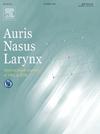Treatment outcomes of primary salivary gland squamous cell carcinoma: A multi-institutional retrospective study in Japan
IF 1.6
4区 医学
Q2 OTORHINOLARYNGOLOGY
引用次数: 0
Abstract
Objective
Primary salivary gland squamous cell carcinoma (SCC) is extremely rare, accounting for 0.3–10.4 % of all salivary gland malignancies. Due to this rarity, the clinical characteristics of primary salivary gland SCC remain unelucidated. In the present study, we conducted a multi-institutional retrospective analysis—including a large number of cases compared with that of previous studies—to reveal the prognosis, treatment outcomes, and prognostic factors of primary salivary gland SCC.
Methods
The clinical course of patients with primary salivary gland SCC between January 2012 and December 2022 was retrospectively investigated. Thirteen university hospitals and cancer centers in Japan participated in this study. The diagnosis of primary salivary gland SCC was based on the following criteria: 1) pathological diagnosis of SCC and exclusion of other histological types and 2) exclusion of metastatic SCCs from other organs. Progression-free and overall survival rates were compared using Kaplan–Meier curves and log-rank tests. Treatment outcomes were assessed using univariate and multivariate analyses with Cox proportional hazards models.
Results
In total, 723 patients with salivary gland cancer were admitted to the participating institutions. Among them, 63 patients (8.7 %) were diagnosed with primary salivary gland SCC. The clinical courses of the 58 patients that received definitive treatment and had complete data were analyzed. Primary treatments included surgery in 35 patients (60.3 %), chemoradiotherapy in 16 (27.6 %), radiotherapy in 5 (8.6 %), and chemotherapy in 2 (3.4 %). Complete response and objective response rates to chemoradiotherapy were 62.5 % and 93.8 %, respectively. Five-year progression-free and overall survival rates were 30.1 % and 60.1 %, respectively. Five-year progression-free survival rates for each treatment were 37.7 % (surgery), 33.0 % (chemoradiotherapy), 0 % (radiotherapy), and 0 % (chemotherapy). Overall survival rates were 71.5 % (surgery), 39.5 % (chemoradiotherapy), 53.3 % (radiotherapy), and 0 % (chemotherapy). Multivariate analysis revealed that age ≥70 years, N classification ≥1, and surgery were independent predictors of progression-free (hazard ratios: 3.75, 2.46, and 0.33, respectively) and overall survival (hazard ratios: 3.11, 6.24, and 0.32, respectively). Adjuvant radiotherapy significantly improved progression-free and overall survival in patients with stage Ⅳ cancer or positive surgical margins. Log-rank tests revealed no significant difference between patients with or without elective neck dissection in progression-free and overall survival; however, a relatively high percentage of occult lymph node metastasis (50.0 %) was observed.
Conclusion
Surgical resection is a favorable first-line treatment option in salivary gland SCC, and definitive chemoradiotherapy would show acceptable complete and objective response rates.
原发性唾液腺鳞状细胞癌的治疗结果:日本的一项多机构回顾性研究。
目的:原发性唾液腺鳞状细胞癌(SCC)极为罕见,占所有唾液腺恶性肿瘤的0.3- 10.4%。由于这种罕见性,原发性唾液腺鳞状细胞癌的临床特征仍不清楚。在本研究中,我们进行了多机构回顾性分析,包括与以往研究相比的大量病例,以揭示原发性唾液腺鳞状细胞癌的预后、治疗结果和预后因素。方法:回顾性分析2012年1月至2022年12月原发性唾液腺鳞状细胞癌患者的临床病程。日本的13所大学医院和癌症中心参与了这项研究。原发性唾液腺鳞状细胞癌的诊断依据如下标准:1)病理诊断为鳞状细胞癌并排除其他组织学类型;2)排除其他器官转移性鳞状细胞癌。采用Kaplan-Meier曲线和log-rank检验比较无进展生存率和总生存率。采用Cox比例风险模型进行单因素和多因素分析,评估治疗结果。结果:参与机构共收治唾液腺癌患者723例。其中63例(8.7%)被诊断为原发性唾液腺SCC。对58例接受明确治疗且资料完整的患者的临床病程进行分析。主要治疗包括手术35例(60.3%),放化疗16例(27.6%),放疗5例(8.6%),化疗2例(3.4%)。放化疗的完全缓解率为62.5%,客观缓解率为93.8%。5年无进展生存率和总生存率分别为30.1%和60.1%。每种治疗的5年无进展生存率分别为37.7%(手术)、33.0%(放化疗)、0%(放疗)和0%(化疗)。总生存率分别为71.5%(手术)、39.5%(放化疗)、53.3%(放疗)和0%(化疗)。多因素分析显示,年龄≥70岁、N分类≥1和手术是无进展(风险比分别为3.75、2.46和0.33)和总生存(风险比分别为3.11、6.24和0.32)的独立预测因素。辅助放疗显著改善了Ⅳ期癌症或手术切缘阳性患者的无进展期和总生存率。Log-rank检验显示,选择性颈淋巴清扫患者的无进展生存期和总生存期无显著差异;然而,隐匿性淋巴结转移的比例相对较高(50.0%)。结论:手术切除是唾液腺鳞状细胞癌的一线治疗选择,明确的放化疗可获得可接受的完全和客观缓解率。
本文章由计算机程序翻译,如有差异,请以英文原文为准。
求助全文
约1分钟内获得全文
求助全文
来源期刊

Auris Nasus Larynx
医学-耳鼻喉科学
CiteScore
3.40
自引率
5.90%
发文量
169
审稿时长
30 days
期刊介绍:
The international journal Auris Nasus Larynx provides the opportunity for rapid, carefully reviewed publications concerning the fundamental and clinical aspects of otorhinolaryngology and related fields. This includes otology, neurotology, bronchoesophagology, laryngology, rhinology, allergology, head and neck medicine and oncologic surgery, maxillofacial and plastic surgery, audiology, speech science.
Original papers, short communications and original case reports can be submitted. Reviews on recent developments are invited regularly and Letters to the Editor commenting on papers or any aspect of Auris Nasus Larynx are welcomed.
Founded in 1973 and previously published by the Society for Promotion of International Otorhinolaryngology, the journal is now the official English-language journal of the Oto-Rhino-Laryngological Society of Japan, Inc. The aim of its new international Editorial Board is to make Auris Nasus Larynx an international forum for high quality research and clinical sciences.
 求助内容:
求助内容: 应助结果提醒方式:
应助结果提醒方式:


